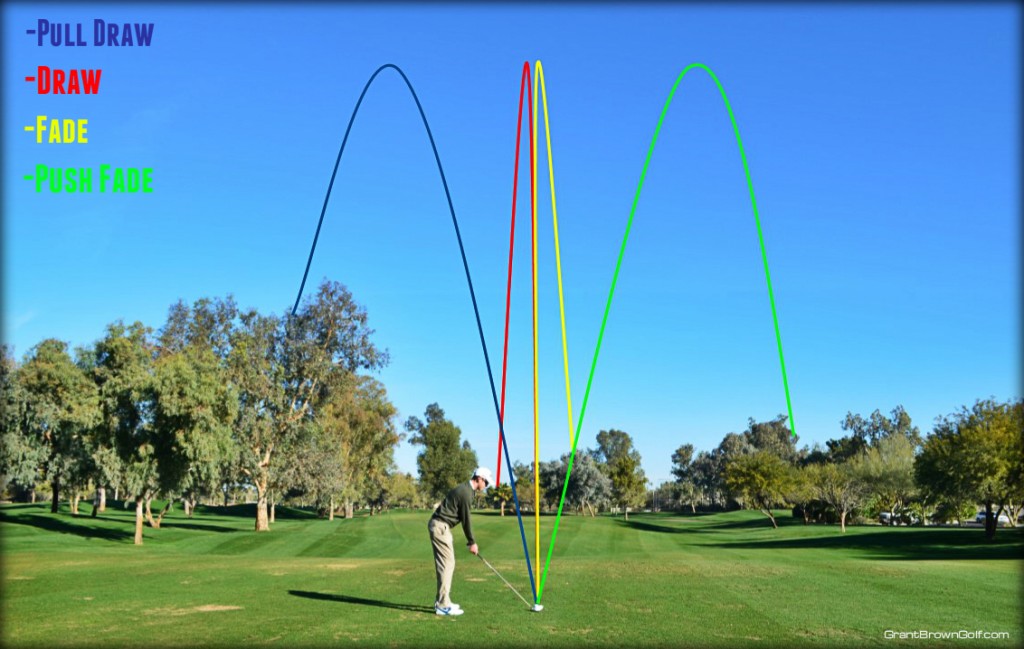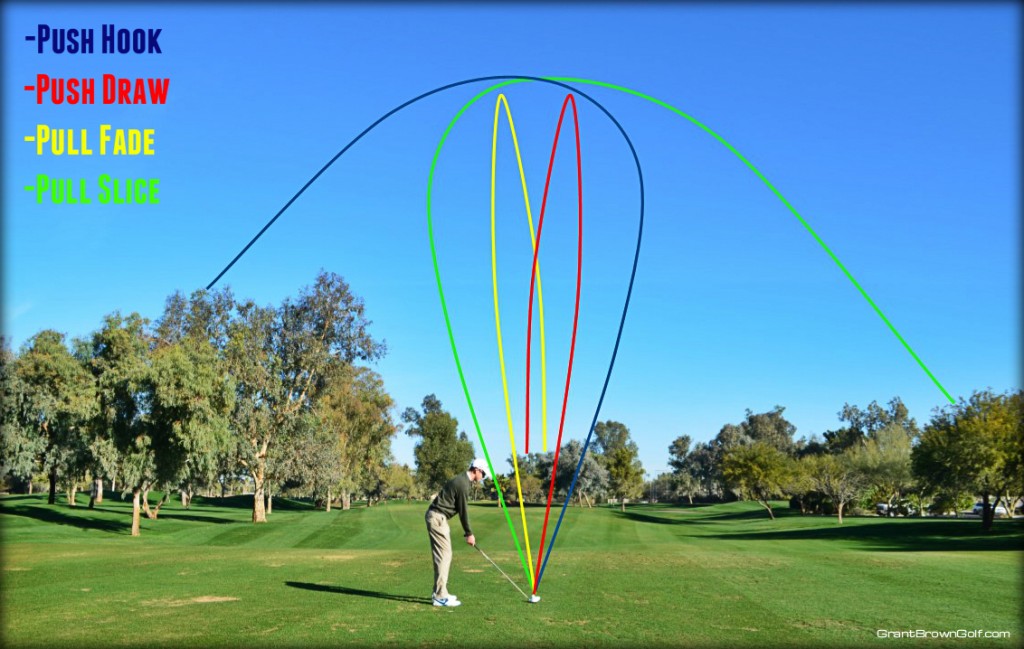-
Ball Flights
I pay close attention to my ball flights on all shots. Based on what I see the ball doing in the air, I can diagnose swing flaws before they become habits. The flight of the golf ball always tells me what my club-face and swing-path were doing at impact.
“Slices” and “fades” curve to my right while “hooks” and “draws” work to my left. Also, an “open club-face” points to the right and a “closed club-face” points to the left of the target. The direction the club-face points at impact determines the beginning line for every shot.
In the pictures below, I define 16 different ball flights along with some unwanted swing flaws.
 Disclaimer: All descriptions below are from the right-handed golfer’s perspective. Also, all swing flaws discussed assume that the set-up position is correct. If you correct your set-up (grip, width of stance, posture, ball placement, feet/shoulder/club-face alignment and balance), you will be well on your way to fixing your swing flaws.
Disclaimer: All descriptions below are from the right-handed golfer’s perspective. Also, all swing flaws discussed assume that the set-up position is correct. If you correct your set-up (grip, width of stance, posture, ball placement, feet/shoulder/club-face alignment and balance), you will be well on your way to fixing your swing flaws.The causes/swing flaws mentioned below are the most common that I see on a regular basis in my lessons. However, since every golfer has their own tendencies, the swing flaws that lead to each ball flight can differ from person to person.
Pull draw: Ball starts left and curves farther left.
Common set-up flaw: Aiming too far left with shoulders.
Common swing flaw: Swinging slightly too fast with the upper body at the start of the downswing which causes an over-the-top motion. To correct this, you want to focus on a slower tempo that will allow you to use your lower body to start the down-swing. The use of the lower body will square the club-face at impact and allow you to make a more inside-to-out swing through impact.
Draw: Ball starts straight and curves slightly left.
This is considered the optimum shot by most amateurs. To use this shot effectively, make sure to aim shoulders and feet a little right of your target.
Fade: Ball starts straight and then curves slightly right.
This is my favorite shot because a ball that curves right has more back-spin than a ball that curves left. I used to hit a lot of shots left out of bounds until I realized the following: A ball that curves left has more over-spin and likes to run out of bounds. A ball that starts right or curves right, usually never gets too far out of control. Ever since, I have always favored working the ball to the right.
Push fade: Ball starts right and then curves slightly right.
Common set-up flaw: Aligning feet too far right of target and shoulders too far left of target.
Common swing flaw: Usually this is caused by a slightly over-the-top downswing while slightly sticking out the left elbow through impact. To correct this flaw you want to focus on your right forearm rotating smoothly over the left forearm through impact.
 Pull hook: Ball starts left and curves extremely left.
Pull hook: Ball starts left and curves extremely left.Common set-up flaw: Aligning feet too far right of target and shoulders too far left of target.
Common swing flaw: A magnified version of the pull-draw defined above. (Swinging too fast with the upper body at the start of the downswing which causes an over-the-top motion on the down-swing.)
Hook: Ball starts straight and then curves extremely left.
Common swing flaw: Hanging back on your right foot through impact. A lot of times when this shot happens, you will notice that you hit the ground a little before impact.
Slice: Ball starts straight and then curves extremely right.
Common set-up flaw: Aligning feet too far right of target and shoulders too far left.
Common swing flaw: Head and left elbow move toward the target through impact. Instead, the head should stay steady while the forearms/elbows smoothly rotate through impact all the way to the finish.
Push Slice: Ball starts right and then curves extremely right.
Common set-up flaw: Aligning feet too far right of target and shoulders left of where feet are aligned.
Common swing flaw: Starting the down-swing with the hands and then holding the left elbow out toward the target through impact. To cure this ball flight, you need to feel like you are swinging the club-head out toward first base while trying to rotate your right forearm over the left toward third base.
 Push hook: Ball starts right and then curves severely left.
Push hook: Ball starts right and then curves severely left.Common set-up flaw: Lining up too far to the right with shoulders and feet.
Common swing flaw: Making the same swing discussed above in “Hook.”
Push draw: Ball starts a little right of the target and then curves slightly to the left. This is a perfect shot if you were aligned to the right of the target, and were trying to hit a draw. No need to change anything.
Pull fade: Ball starts a little left of target and then curves slightly to the right. This is another perfect shot if you were aligned to the left of the target, and were trying to hit a fade.
Pull Slice: Ball starts left of target and then curves extremely to the right.
Common set-up flaw: Aligning feet too far right of target and shoulders too far left of target.
Common swing flaw: Starting the down-swing with the hands while the head and left elbow move toward the target through impact. Instead of moving toward the target, the head should stay steady while the forearms/elbows smoothly rotate through impact.
Conclusion: Ball Flights can tell you a lot about your swing. Remember that your set-up is the main key to hitting the ball where you want it to go. Swing flaws are mostly caused by bad habits formed from a bad set-up. (Click here to see other posts about the set-up.)
I hope this post can be a resource for you when you see your ball flights getting out of control.
Happy Ball Flighting!
GB





